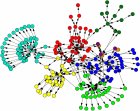If you haven't heard the buzz yet, yesterday Charles
"Bell Curve" Murray wrote the first of a three part series on
general intelligence (g) and education in the
Wall Street Journal. To say that Dr. Murray is no stranger to the controversial research on general intelligence (g) and race, gender, and education, is a understatement. He has published extensively, and not without controversy, on black/white IQ differences, male/female IQ differences, the Flynn Effect, etc.
Dr. Murray's first installment in the WSJ was called
"Intelligence in the Classroom." A free copy (available from the AEI think tank where he is a scholar) can be found by
clicking here.
Dr. Murray, in his series, is attempting to lay out
"three truths about the mediating role in intelligence that should bear on the way we think about education and the nation's future." His first truth is -
"Half of all children are below average in intelligence. We do not live in Lake Wobegon."
Blog readers can digest the article themselves. But, I do want to offer a few comments.
Briefly, the article is largely the articulation of the standard nativist's position that there are inherent (and largely genetically determined) individual differences in general intelligence (g) and educational reformers simply need to wake up and small the coffee...not all students, and esp. those below the 50th percentile, should be expected to achieve the same common set of high standards as per recent educational reforms as NCLB.
Dr. Murray is correct that general IQ is the single best predictor of school achievement. However, at best, g
eneral intelligence has been repeatedly shown to account for no more than 40% to 50% of the variance of achievement. This suggests, IMHO, that higher achievement can indeed be obtained by many
individuals who may
"suffer from the soft bigotry of low expectations"...this time grounded in the concept of fixed general intelligence.
As I've written before (click
here and
here for starters), non-cognitive factors (self-efficacy; self-regulated learning strategies; motivational orientation; etc.), human characteristics that are more amenable to intervention and change, exert significant effects on school learning and can be targeted to improve achievement for most all students. There is more to school learning than IQ. There is intelligence (IQ)...but then there is
"intelligent performance and behavior" (IQ + conative or non-cognitive variables).
I could go on and on. Instead, I refer readers to a report I previously wrote re: this issue. It is often referred to as the
"Forrest Gump" report. The report, IMHO, points out a serious flaw in Dr. Murray's logic...namely, that a specific IQ (esp. low IQ dooms a person to a lower set of achievement expectations). The bottom line...there is a normal distribution of achievement around any IQ score, whether it be below the 50th percentile or above. My point in the Gump report is that for any
individual person, their general IQ score is not accurate enough to deny any individual to reasonably appropriate and high academic expectations.
However, Dr. Murray's position does fit with the extant body of
group (vs
individual) based intelligence research that suggests that, on the average, interventions to raise IQ and achievement have meet with limited success. This is one reason why the
mastery learning experiment (which I have always maintained has conceptually been reborn in the form of
NCLB) ran up against a major dilemma in individual differences/learning research....the "
time-achievement equality dilemma." [That is another who series of potential posts...readers can check out one of the best literature reviews on this dilemma--
Time, Equality,and Mastery Learning in 1984, by Arlin, in Review of Educational Research, which is at the heart of Dr. Murray's thesis, by
clicking here.]
In simple terms....educational psychology research has repeatedly shown us that at the
group level (not to be confused with my
individual Forrest Gump expectations report), education policy can either
hold instructional time constant,
and then achievement will vary as per the normal curve, or can attempt to
hold achievement constant (standard expectations for all), and time will then vary as per the normal curve. This is the rub against which NCLB is now bumping up against. We have been here before. The educational research suggests, IMHO, that we can likely move the mean level of educational achievement (I'm not sure how far) via attention to variables "beyond IQ", such as instructional time, quality of instruction, high standards and expectations, interventions focused on non-cogntive/conative characteristics of students, etc., but that there still will be a normal distribution around the new mean. This is still a laudable goal.
Enough said by me.
Dr. Murray's second WSJ article, "What's wrong with vocational school?" can be found by
clicking here. I've not yet read it.
Technorati Tags:
pscyhology,
education,
educational psychology,
school psychology,
neuropsychology,
NCLB,
intelligence,
IQ,
IQ test,
IQ score,
Charles Murray,
Bell Curve,
general intelligence,
g,
conative,
aptitude,
learningpowered by
performancing firefox
 All the news thats fit for IQ's Corner readers:
All the news thats fit for IQ's Corner readers:






